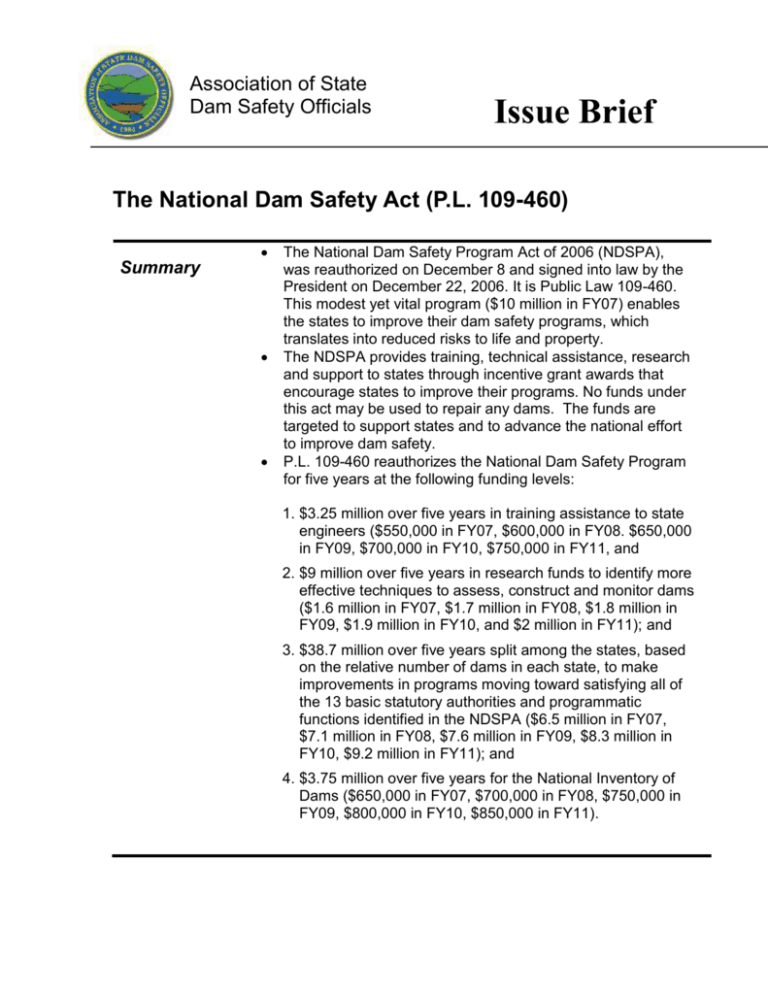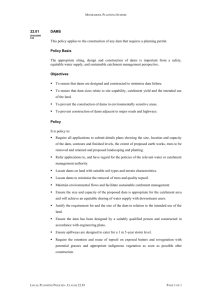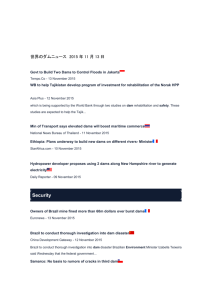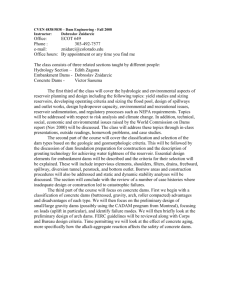Issue Brief - Association of State Dam Safety Officials
advertisement

Association of State Dam Safety Officials Issue Brief The National Dam Safety Act (P.L. 109-460) Summary The National Dam Safety Program Act of 2006 (NDSPA), was reauthorized on December 8 and signed into law by the President on December 22, 2006. It is Public Law 109-460. This modest yet vital program ($10 million in FY07) enables the states to improve their dam safety programs, which translates into reduced risks to life and property. The NDSPA provides training, technical assistance, research and support to states through incentive grant awards that encourage states to improve their programs. No funds under this act may be used to repair any dams. The funds are targeted to support states and to advance the national effort to improve dam safety. P.L. 109-460 reauthorizes the National Dam Safety Program for five years at the following funding levels: 1. $3.25 million over five years in training assistance to state engineers ($550,000 in FY07, $600,000 in FY08. $650,000 in FY09, $700,000 in FY10, $750,000 in FY11, and 2. $9 million over five years in research funds to identify more effective techniques to assess, construct and monitor dams ($1.6 million in FY07, $1.7 million in FY08, $1.8 million in FY09, $1.9 million in FY10, and $2 million in FY11); and 3. $38.7 million over five years split among the states, based on the relative number of dams in each state, to make improvements in programs moving toward satisfying all of the 13 basic statutory authorities and programmatic functions identified in the NDSPA ($6.5 million in FY07, $7.1 million in FY08, $7.6 million in FY09, $8.3 million in FY10, $9.2 million in FY11); and 4. $3.75 million over five years for the National Inventory of Dams ($650,000 in FY07, $700,000 in FY08, $750,000 in FY09, $800,000 in FY10, $850,000 in FY11). Benefits The state assistance grants are based on the number of dams in each of the participating states and are used as an incentive to encourage states to improve their program by meeting basic criteria such as: • • • State statutory authority to conduct inspections of dams; State authority to require repairs to unsafe dams; and State policies that address dam site security at non-federal dams. Use of these funds helps states meet their own unique challenges. States have utilized funds to perform dam failure and dam stability analyses, to hire additional staff to conduct inspections and to conduct owner education workshops. In addition, funds have enabled states to provide additional staff training, and to purchase equipment such as computers, field survey equipment and software, and remote operated cameras for internal inspections. Several states have utilized the grant funds to develop Graphic Information Systems (GIS) to identify the locations of their dams and to map the areas below the dams that would flood in the event of a dam failure. This is especially critical in case the area has to be evacuated. The training program provides access to technical courses and workshops that state engineers could not otherwise attend. Examples include Dambreak Analysis, Concrete Rehabilitation of Dams, Slope Stability of Dams, Earthquake Analysis, Emergency Action Planning and many others including recent training in Dam Site Security. The Research Program is an important program to all within the dam safety community. Its funds have been used to identify future research needs such as inspections using ground penetrating radar or risk analysis. In addition, these funds have been used to create a national library and database of dam failures and dam statistics at the National Performance of Dams Program at Stanford University as well as a national clearinghouse and library of dam safety bibliographic data at ASDSO. Research funds are currently being used to provide best management practices documents and tools, guidebooks for dam owners and engineers, and security assessment tools for states to utilize in addressing potential terrorist actions against the 75,000 non-federal dams. Background ASDSO Staff Contact In ASCE’s 2005 Report Card for America’s Infrastructure, dams received a grade of D. Additionally, it has been noted that there are 3,500 unsafe dams in the United States, which have deficiencies that leave them highly susceptible to failure. Dams provide tremendous benefits including water supply, flood protection, hydroelectric power, irrigation and recreation. There are over 78,000 dams in the United States; however, only 5% of those dams are owned, operated or regulated by Federal agencies (USACOE, DOI, FERC, TVA, etc.). The bulk of the responsibility to assure the safety of the nation’s dams falls on the shoulders of the states. Many state programs are understaffed and under funded to carry out the job and still others are truly overwhelmed by the task. The Federal government has an important leadership role, considering that dam failures cause loss of life and significant damage to downstream property and critical infrastructure. Funds to repair and recover after a dam failure come from the Federal government through the National Flood Insurance Program and from the President’s disaster relief fund. Dam failures do not respect state boundaries and often dams in one state may threaten people and property downstream in a neighboring state. Clearly there is a need for Federal leadership to support state dam safety programs similar to the bridge inspection program of the Federal Highway Administration The National Inventory of Dams is a large database of over 79,000 dams in the United States, developed, updated and maintained by the Army Corps of Engineers. The database provides important information such as size, location, purpose, age, etc. about the country’s dams. It is extremely valuable in assessing the changes in the nation’s dams (new dams built, major dam rehabilitations, dams removed, etc.) Lori C. Spragens Executive Director Phone: 859-257-5140, Fax 859-323-1958, lspragens@damsafety.org








